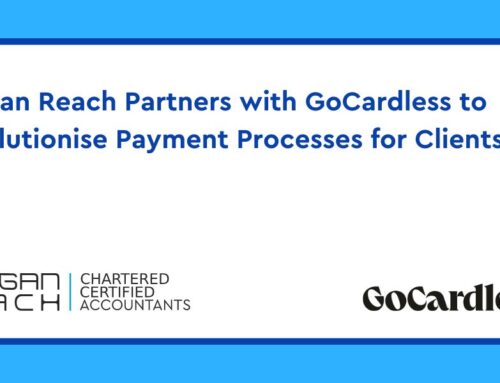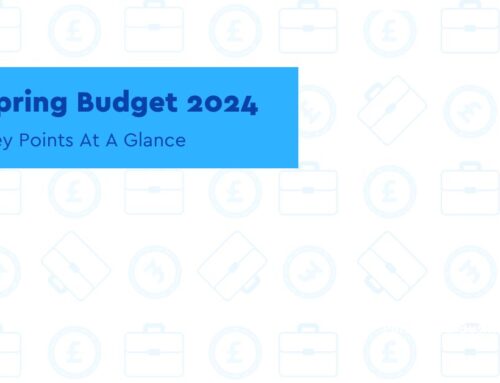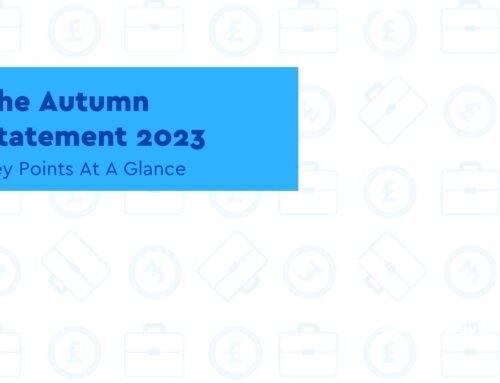News – Finance
Five ways SMEs can get financial support for their business
Key Points
- Employment Allowance allows eligible businesses to reduce their National Insurance contributions bills each year
- The government has cut fuel duty on petrol and diesel by 5 pence per litre for 12 months
HMRC has recently contacted SMEs about government support they can access now, to help them invest and grow over the coming years.
Claim up to £5,000 with the Employment Allowance
Employment Allowance is a tax relief which allows eligible businesses to reduce their National Insurance contributions (NICs) bills each year.
You can claim Employment Allowance if you’re a business and your employers’ Class 1 National Insurance liabilities were less than £100,000 in the previous tax year. You can also claim Employment Allowance for the previous 4 tax years dating back to the 2018 to 2019 tax year. Some of the rules for claiming are different. You can only claim Employment Allowance against one of the payrolls.
The Allowance recently increased from £4,000 to £5,000 to further benefit SMEs in a tax cut worth up to £1,000 for nearly half a million SMEs (30% of all businesses).
This includes around 50,000 businesses which will be taken out of paying NICs and the Health and Social Care Levy entirely.
Get a discount of up to £5,000 on software, with Help to Grow
Help to Grow: Digital is a UK-wide government-backed scheme that aims to help businesses choose, buy and adopt digital technologies that will help them grow their business.
Eligible businesses can receive a 50% discount on buying new software worth up to £5,000 per SME, alongside free impartial advice and guidance about what digital technology is best suited to boost their business performance.
The Help to Grow: Management scheme provides small businesses with access to world-class business expertise on everything from leadership and financial management to marketing and digital adoption. This is delivered through leading UK business schools, alongside one-on-one support from a business mentor – and is 90% funded by the government.
By the end of the programme they will develop a business growth plan to help them lead and grow their business. To be eligible, you must be a UK-based SME, actively trading for at least one year and have a total of between 5 and 249 employees.
For more information and to apply, visit Help to Grow on GOV.UK.
Get up to half off your business rates
From April this year, small retail, hospitality, and leisure businesses can benefit from 50% off their business rates bills, worth £1.7bn for up to 400,000 eligible properties.
The business rates multiplier has also been frozen for another year, saving businesses £4.6 billion over the next 5 years. This is used to calculate how much business rates they should pay, and it usually rises with inflation each year.
The business rates multipliers for 2022 to 2023 are 49.9 pence for the small business multiplier and 51.2 pence for the standard multiplier.
From April 2022 there will be no business rates due on a range of green technology, including solar panels and batteries, whilst eligible heat networks will also receive 100% relief. Together these will save businesses around £200 million over the next five years.
Invest in your business with Super-deduction and Annual Investment Allowance
To spur business investment, the super-deduction allows companies to cut their tax bill by 25 pence for every £1 they invest in any qualifying machinery and equipment. This can include the purchase of computers, most commercial vehicles and office furniture.
The temporary £1 million limit for the Annual Investment Allowance has also been extended to the end of March 2023. This had been due to revert to £200,000 at the start of 2022.
The Annual Investment Allowance allows businesses to spend up to £1 million on qualifying business equipment, and deduct in-year its full cost before they calculate their taxable profits.
Both of these tax breaks remain available for firms to take advantage of until the end of March 2023, by incurring qualifying expenditure before then.
Benefit from the cut in Fuel Duty
The government has cut fuel duty on petrol and diesel by 5 pence per litre for 12 months – effective from March 23, 2022. Calculations by the RAC show that a 5p cut in fuel duty would shave around £3 off the cost of filling a 55-litre family car.
This cut, plus the freeze in fuel duty in 2022 to 2023, represents a £5bn saving worth around:
- £200 for the average van driver
- £1,500 for the average haulier
News – Business
HMRC urges businesses to move to new customs IT platform now to continue trading
Key Points
- Correspondence includes further information about making the move to the UK’s single customs platform
- They also set out the steps businesses must take now to ensure they can continue trading
HMRC is urging businesses to move to its new customs IT platform now to continue trading, and is writing to businesses to support them with the changes.
The letters and emails include further information about making the move to the UK’s single customs platform – the Customs Declaration Service – and set out the steps businesses must take now to ensure they can continue trading. They also signpost to online resources to support businesses through the process.
Whether you make your own declarations or use an intermediary, HMRC is urging you to act now to plan and make your move to the Customs Declaration Service. It can take some time to complete the preparation needed and the sooner you start, the easier it will be.
The Customs Declaration Service supports making import and export declarations when moving goods into and out of the UK. It is a resilient, reliable and adaptable IT platform, which replaces the Customs Handling of Import and Export Freight (CHIEF), and is the first step of the UK border transformation.
The CHIEF system is closing for import declarations after September 30, 2022. After March 31, 2023, the ability to make exports declarations will end and the CHIEF service will close.
Benefits of the Customs Declaration Service
The Customs Declaration Service saves businesses time by:
- Allowing you to submit customs documents digitally and safely using the Secure File Upload service
- Providing access to all your financial information in a single financial dashboard where you can view account statements, make payments and control standing authority
- Giving real time notifications and alerts on all your customs declarations and movements
- Allowing you to manage your business finances by opening a duty deferment account, make payments by card or bank transfer enabling your goods to clear without delay
To help businesses plan their move to the Customs Declaration Service, HMRC has published step-by-step checklists.
Businesses can also use the Trader Dress Rehearsal service to help them prepare. The service enables businesses to practise realistic business scenarios using their own account data, test their software and train staff on how to use the Customs Declaration Service, all without risk. Businesses can use this service before they make the move to the Customs Declaration Service.
HMRC has also updated its guidance to help businesses complete import declarations by adding new examples for goods moved under special procedures.
News – Tax Charge
High income child benefit charge catches out taxpayers
Key Points
- The charge was introduced in January 2013 and is not means tested
- If one earner in a family makes more than £50,000 a year, they must pay back 1% of the Child Benefit they receive for every £100 over the threshold
Mistakes made when claiming higher rate child benefit are most frequently the result of poor communication from HMRC, according to recent research.
The high income child benefit charge (HICBC) raised £416m in 2019-20 but it is a hard tax charge to administer as many of the families affected still do not know about the charge and complying with it may involve new tax compliance obligations. An estimated 630,000 people are liable for the tax charge, according to a Freedom of Information request.
The charge was introduced in January 2013 and is not means tested, so if one earner in a family makes more than £50,000 a year, they must pay back 1% of the Child Benefit they receive for every £100 over the threshold. For those with an adjusted net income in excess of £60,000, the tax charge is equal to 100 per cent of child benefit payments received.
However, a basic rate taxpayer can earn £50,270 before falling into the higher rate band. This means basic rate taxpayers are currently in scope for a tax charge aimed at higher earners.
With wages rising the number of people impacted is set to grow as the High Income Child Benefit threshold has not been moved since it was introduced.
Research commissioned by HMRC has identified four main barriers which led to taxpayers either failing to take action in relation to the charge, taking action too late or making errors.
It was common for people to experience multiple barriers at different stages of their application process, which sometimes led to repeated errors.
The main obstacles were:
- Lacking awareness of the charge, sometimes several years into building up the charge;
- Not accurately understanding important details of HICBC or child benefit, eg, that it is the taxpayer’s responsibility to notify HMRC or that child benefit is paid every four weeks;
- Not understanding the process of complying, eg. completing self-assessments, paying through tax code adjustment or opting out; and
- Having complex earnings in the form of composite or fluctuating incomes leading to errors in accurately paying the charge.
Participants reported that communication from HMRC could sometimes exacerbate these barriers, particularly where initial letters were not targeted or clear, or communication about ongoing compliance was delayed.
Communication from HMRC was seen as a helpful source of support by participants who did not understand their role, lacked confidence in their capability, or needed to organise a payment plan to pay the charge they owed.
But respondents generally wanted to see improvements in the quality of communications from HMRC to improve understanding of taxpayer liability. They wanted to see improvements in the understanding of the process of meeting liability by ensuring taxpayers have access to the help they need to pay the charge. People also wanted clearer and more comprehensive information available online. Promotion of existing tools such as the Child Benefit tax calculator could help to meet this need.
It is the responsibility of the individual taxpayer to notify HMRC of liability for the charge via self assessment and since it was introduced nine years ago, there has been ongoing criticism of the quality of communications and clarity about the charge. There are also issues when people opt out as they can lose national insurance contributions credit which contribute to the state pension. These can be paid separately as a top-up but this is also not widely known.
For participants who opted out, their decision was largely driven by the knowledge that they would not gain anything financially (all had an individual income more than £60,000). A further motivation for opting out was to avoid the administrative burden, including filing self assessment returns, associated with paying the charge.
The report concluded: ‘Despite increased activity by HMRC to help customers to comply with HICBC, there is evidence of some groups of customers returning to non-compliance following an intervention from HMRC. Supporting customers to comply with HICBC therefore remains a priority for HMRC.’
One way someone can avoid the HICB charge is by taking a look at their pension. The HICB charge is on income after pension contributions, so if someone pays more into their pension they can fall below or closer to the threshold, thus increasing the amount of Child Benefit they receive while also taking advantage of the tax relief on pension contributions.
Am I eligible?
You may be able to claim Child Benefit if any of the following apply:
- Your child is under 16
- Your child is between 16 and 20 and is in relevant education or training
- Your child is 16 or 17, has left relevant education or training and is registered for work, education or training with an approved body
You will get a higher rate of Child Benefit for your eldest or only child, and then a lower rate for any additional children. Guardian’s Allowance is an extra amount that some people get on top of Child Benefit.
This article was sourced from Accountancy Daily, IFA Magazine and London Borough of Redbridge
News – Employee Benefits
What employee benefits can attract new hires to your business?
Key Points
- Employee benefits are offered alongside a salary and are designed to attract employees to your business.
- You’re legally required to offer employees a set of statutory benefits
Employee benefits help you attract, retain, and reward your staff. What are employee benefits and what could you offer?
What are employee benefits?
Employee benefits are usually part of an overall compensation package for staff. They aren’t seen as part of a pay packet (although they’re usually taxed).
Instead, they’re offered alongside a salary and are designed to attract employees to your business. They help motivate employees to stay at your business and do their job well (for reasons other than their monthly paycheque).
Recent changes in the way firms view employee benefits have placed more emphasis on flexibility rather than giving employees fixed options.
Employee benefits in UK
Employee benefits examples: what’s legally required?
You’re legally required to offer employees a set of statutory benefits:
Automatic pension enrolment – by law, you must offer your employees a workplace pension and pay the minimum employer contributions.
Holiday allowance – employees are entitled to a minimum of 28 days’ paid annual leave, which can include bank holidays (many businesses offer more than the minimum).
Sick pay – employees can get statutory sick pay (SSP) from the fourth qualifying day of illness, up to 28 weeks.
Maternity leave – new mothers are entitled to 52 weeks of leave (paid up to 39 weeks).
Paternity leave – new fathers are entitled to one or two weeks of paid leave.
Adoption leave – if an employee is adopting, they’re also entitled to 52 weeks of leave (paid up to 39 weeks).
Parental leave – for each child (up to age 18), an employee can take up to 18 weeks of unpaid leave to care for them.
Flexible working – an employee can request to work flexibly (for example, remotely or part-time) after 26 weeks of continuous employment, but businesses can weigh the request against business needs and reject it with a good enough reason.
Employee benefits examples: other types of employee benefits
Many businesses offer more than what’s required by law. Have a think about:
Healthcare – you can offer full private medical insurance (which both covers and gives access to treatment) or a smaller-scale health cash plan, which pays out for things like dental and optical costs. Businesses are also increasingly offering access to mental health support.
Cover for illness or death – insurance is available for employees that covers their income if they’re unable to work because of illness or disability, plus life assurance pays out money to an employee’s beneficiaries if they die while they’re employed by you.
More pension contributions – some businesses choose to offer more than the minimum requirement, as well as educate their employees about pensions (and their finances in general).
Bonuses – a bonus scheme incentivises employees to go beyond the requirements of their role. Bonuses can work for employees in roles that are target-driven (like sales), or you can offer an annual bonus to all employees at the same rate, decided on business performance.
Other employee benefits examples include:
- Cycle to work scheme (which has tax and National Insurance savings for staff and VAT savings for employers)[Text Wrapping Break]
- Season ticket loans for travel (with tax relief available)[Text Wrapping Break]
- £55 of childcare vouchers or employer-contracted childcare per week (which is free of tax and National Insurance)[Text Wrapping Break]
Employee benefits and your culture
There are also examples of employee benefits that are more to do with your business’s culture than you offering specific products.
For example, is it easy for your employees to work flexibly (and by extension do you trust them to get their work done)?
Plus, is there space in the office for them to focus on their wellbeing, and do you carve out time for them to connect with each other?
In terms of employee benefits, an office pool table and beers on Friday have become clichéd, with many businesses recognising that the overall culture needs to be positive and stimulate employee connections and wellbeing.
But they do represent the need for employees to spend time with each other, so think about what social activities make sense for your business.
And finally, consider flexible benefits and voluntary benefits.
Employees can choose from a set of flexible benefits to form their overall benefit package (think gym memberships and cinema vouchers). This empowers the employee to have benefits that are right for them.
Meanwhile voluntary benefits are often extra levels to an employee’s core benefits that they can choose and pay for at discounted rates. For example, you might offer the basic level of a health cash plan to every employee, while giving them the option to pay for the next level at the group rate (which is cheaper than if they accessed it as an individual).
Should you use an employee benefits platform?
As we’ve established, employee benefits packages can be varied and diverse. The examples above are intended to give you a flavour of what you could offer.
It’s best to research what’s best for your business by speaking to current employees, or working on your business’s values.
Considering that benefits can be diverse, you could invest in an employee benefits platform to help retain employees. With these, your employees log in to the platform and choose flexible benefits that make sense for them.
Platforms like this also offer more for your money, including methods that help employees connect and celebrate each other, as well as wellbeing resources.
Platforms to look at as part of your research include:
- Perkbox[Text Wrapping Break]
- Reward Gateway[Text Wrapping Break]
- Zest[Text Wrapping Break]
Be sure to weigh up the cost of these platforms against what you hope to gain, whether it’s more interest from prospective employees or higher employee retention.
Employee benefits and taxes
The tax considerations behind employee benefits can be complicated, but most employee benefits do come with tax and National Insurance responsibilities.
Cash benefits like bonuses and commission are handled in the same way as salary through PAYE. Non-cash benefits are known as benefits in kind and can be treated differently, with you reporting them using HMRC’s P11D form. However, you can also payroll benefits.
What is a trivial benefit?
A trivial benefit is a small employee benefit with no tax due. Trivial benefits include benefits that:
- Cost you £50 or less to provide[Text Wrapping Break]
- Aren’t cash or a cash vouchers[Text Wrapping Break]
- Aren’t a reward for an employee’s work or performance[Text Wrapping Break]
- Aren’t in the terms of their contract[Text Wrapping Break]
A trivial benefit has to meet all of the criteria above. You don’t have to pay tax or National Insurance, or let HMRC know about them.
Examples of trivial benefits include taking employees out for lunch to celebrate a birthday, or giving employees a Christmas present.
A team lunch to celebrate targets being met won’t be a trivial benefit, as this relates to work and performance.
This article was derived from Simply Business: https://www.simplybusiness.co.uk/knowledge/articles/2022/04/employee-benefits-guide/
Latest Snippets
Savers warned against pausing pension contributions in face of financial ‘triple whammy’
Pausing pension contributions due to the ‘triple whammy’ of increasing inflation, a freeze in income tax thresholds and the rise in National Insurance could be dangerous for savers.
With the latest inflation rate showing CPI sitting at a 30-year high of 7 per cent and people looking for ways to relieve financial pressures in the coming months, it has been suggested that many could be tempted to pause workplace pension contributions.
Aegon analysis showed a one-year pension contribution break could mean a 25-year-old on average earnings, and contributing the minimum auto-enrolment level, could miss out on £4,600 at state pension age. The firm also revealed that pausing for two or three years could lead to missing out on £9,100 and £13,600 respectively.
Whilst also losing out on their own contributions, Aegon warned that a one-year break would mean missing out on £683 of contributions from their employer, warning that forfeiting these valuable contributions effectively means you lose out on ‘free’ money from the employer.
New homeowners warned over tax refund claims
New homeowners are being warned about cold calls from rogue tax repayment agents advising them to make speculative Stamp Duty Land Tax (SDLT) refund claims, which could leave them with large tax bills.
The warning comes after a recent spate of Stamp Duty refund claims to HMRC failed to meet very specific criteria.
The agents have been known to call new property owners after finding them through Land Registry records and property search websites, promising money back on ‘unknowingly overpaid’ Stamp Duty.
Recent analysis undertaken by HMRC suggests that up to a third of claims for ‘multiple dwelling relief’ refunds were incorrect. HMRC raises enquiries on these claims, but sometimes that is after the agent has taken their fee, leaving the homeowner to pick up the difference.
Incorrect refund claims must be repaid with interest, with some potentially facing penalties as well.
Get In Touch
At Morgan Reach, we understand every business needs a little help now and again-especially when it comes to the financial side of things. Therefore, to help our clients and visitors we endeavour to cover as much of the business news as possible. If you are self-employed or run a business and need assistance and advice on how these news could make a difference to you or your business, feel free to get in touch with the experts at Morgan Reach. Our business growth experts at Morgan Reach will guide you through what support is available for you or your business as well as the latest news that may affect you.







